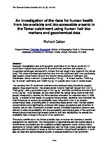An investigation of the risks for human health from bio-available and bio-accessible arsenic in the Tamar catchment using human hair bio-markers and geochemical data
| dc.contributor.author | Cattan, R. | |
| dc.date.accessioned | 2019-05-14T08:11:55Z | |
| dc.date.available | 2019-05-14T08:11:55Z | |
| dc.date.issued | 2010 | |
| dc.identifier.citation |
Cattan, R. (2010) 'An investigation of the risks for human health from bio-available and bio-accessible arsenic in the Tamar catchment using human hair bio-markers and geochemical data', The Plymouth Student Scientist, p.181-232. | en_US |
| dc.identifier.issn | 1754-2383 | |
| dc.identifier.uri | http://hdl.handle.net/10026.1/13919 | |
| dc.description.abstract |
Geologic mineralisation and anthropogenic exploitation in the Tamar catchment of south-west England have resulted in an environment enriched with arsenic, a recognised carcinogen and systemic toxicant that can target many organs in the human body. This study examined geochemical data from the catchment and found particularly high arsenic contamination around the historic mining districts of Callington and Gunnislake, where maximum concentrations of 39 µg L-1 in stream waters, 11000 mg kg-1 in stream sediments, and 15000 mg kg-1 in topsoils were found in certain areas. Hair samples from 91 catchment residents were analysed using inductively-coupled plasma mass spectrometry. The arsenic levels found in their hair ranged from 4.87 to 1150 µg kg-1, with a geometric mean of 43.1 µg kg-1 and 95% confidence interval of 33.7 to 55.2 µg kg-1. Most samples (59.3%) were within the typical range found in hair from people unexposed to arsenic, but three samples exceeded the expected value of 1000 µg kg-1 of arsenic in hair based on accepted dietary intake. Statistical tests indicated the main influences on arsenic bio-availability were living within 5 km of an arsenic-contaminated area, or growing and/ or consuming locally-grown food. The hair arsenic concentrations were significantly correlated with copper, phosphorus and zirconium in topsoils, and pH and conductivity in stream waters. A multiple regression equation was derived to relate bio-availability with bio-accessibility and indicate parts of the catchment where humans may have high arsenic levels in their hair, highlighting the arsenic bio-availability risks of areas in the south of the catchment. This study contributes to the limited available data on human bio-markers of arsenic exposure in the catchment. The incorporation of geochemical and bio-marker data in a combined bio-accessible and bio-available multiple regression model offers a robust alternative for human health risk assessment, and the fitted model could guide land use planning and remediation of areas at risk from arsenic-related health problems. It could also be used with epidemiological studies of disease incidence in the catchment. | en_US |
| dc.language.iso | en | en_US |
| dc.publisher | University of Plymouth | |
| dc.rights | Attribution 3.0 United States | * |
| dc.rights.uri | http://creativecommons.org/licenses/by/3.0/us/ | * |
| dc.subject | mass spectrometry | en_US |
| dc.subject | Geologic mineralisation | en_US |
| dc.subject | anthropogenic exploitation | en_US |
| dc.subject | Tamar catchment | en_US |
| dc.subject | geochemical | en_US |
| dc.subject | contamination | en_US |
| dc.subject | arsenic | en_US |
| dc.subject | sediments | en_US |
| dc.subject | bio-marker | en_US |
| dc.subject | epidemiological studies | en_US |
| dc.title | An investigation of the risks for human health from bio-available and bio-accessible arsenic in the Tamar catchment using human hair bio-markers and geochemical data | en_US |
| dc.type | Article | |
| plymouth.issue | 2 | |
| plymouth.volume | 3 | |
| plymouth.journal | The Plymouth Student Scientist |



